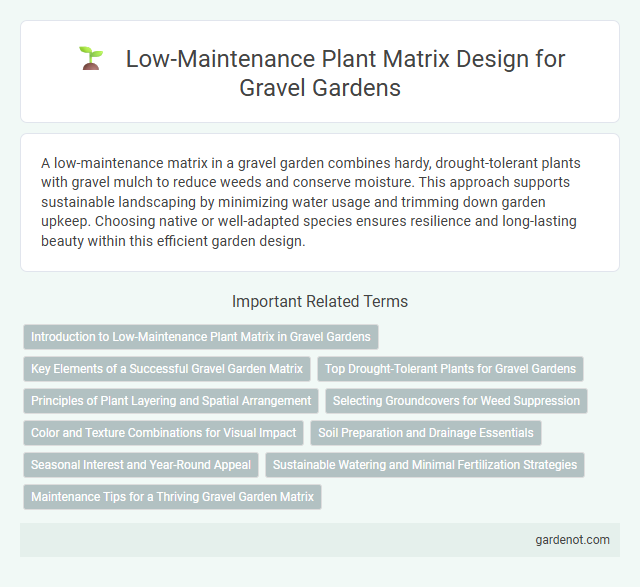A low-maintenance matrix in a gravel garden combines hardy, drought-tolerant plants with gravel mulch to reduce weeds and conserve moisture. This approach supports sustainable landscaping by minimizing water usage and trimming down garden upkeep. Choosing native or well-adapted species ensures resilience and long-lasting beauty within this efficient garden design.
Introduction to Low-Maintenance Plant Matrix in Gravel Gardens
A low-maintenance plant matrix in gravel gardens combines drought-tolerant species like sedum, lavender, and ornamental grasses to create a resilient ground cover requiring minimal watering and upkeep. This matrix enhances soil stability and reduces weed growth by providing dense, layered vegetation adapted to well-drained, nutrient-poor conditions. Incorporating native and xerophytic plants optimizes sustainability and supports local biodiversity within gravel garden landscapes.
Key Elements of a Successful Gravel Garden Matrix
Key elements of a successful gravel garden matrix include selecting drought-tolerant, low-maintenance plants such as succulents, ornamental grasses, and hardy perennials that thrive in well-drained conditions. Incorporating high-quality gravel as ground cover improves drainage, suppresses weeds, and reduces soil erosion, creating a stable growing environment. Strategic placement of rocks and mulching materials enhances moisture retention while maintaining clean aesthetics and minimizing garden upkeep.
Top Drought-Tolerant Plants for Gravel Gardens
Top drought-tolerant plants for gravel gardens include sedum, lavender, and yarrow, known for their resilience and low water needs. These species thrive in well-drained, nutrient-poor soils typical of gravel garden matrices, ensuring minimal maintenance while enhancing biodiversity. Incorporating drought-tolerant perennials and succulents reduces irrigation requirements and supports sustainable landscaping.
Principles of Plant Layering and Spatial Arrangement
A low-maintenance matrix in a gravel garden emphasizes principles of plant layering and spatial arrangement to create sustainable, visually appealing landscapes. Utilizing ground covers, mid-height perennials, and taller shrubs in structured layers optimizes light capture, reduces weed growth, and enhances biodiversity. Strategic spacing ensures efficient water use and airflow, promoting plant health and minimizing upkeep requirements.
Selecting Groundcovers for Weed Suppression
Selecting groundcovers for weed suppression in a gravel garden involves choosing low-maintenance plants with dense, sprawling growth habits that effectively block sunlight from reaching weed seeds. Species such as creeping thyme, sedum, and ajuga thrive in well-drained gravel substrates while minimizing watering and upkeep. These groundcovers also enhance soil stability and contribute to a visually appealing, weed-resistant garden matrix.
Color and Texture Combinations for Visual Impact
A low-maintenance gravel garden thrives through carefully selected color and texture combinations that create striking visual contrast and depth. Incorporating a mix of amber, gray, and rust-colored gravels alongside varied aggregate sizes enhances sensory appeal while requiring minimal upkeep. Pairing these with drought-tolerant plants featuring diverse leaf textures amplifies the garden's dynamic aesthetic, ensuring year-round interest with limited maintenance.
Soil Preparation and Drainage Essentials
Gravel garden success relies on well-prepared soil that promotes adequate drainage and prevents waterlogging. Amending soil with coarse sand or grit enhances permeability and supports healthy plant root systems. Establishing a low-maintenance matrix benefits from soil that balances moisture retention with efficient runoff for sustainable plant growth.
Seasonal Interest and Year-Round Appeal
A low-maintenance gravel garden matrix features drought-tolerant perennials and evergreens that ensure vibrant seasonal interest and year-round appeal. Incorporating hardy grasses, succulents, and flowering shrubs creates dynamic textures and colors throughout spring, summer, autumn, and winter. This sustainable design reduces water usage and upkeep while maximizing visual impact across changing seasons.
Sustainable Watering and Minimal Fertilization Strategies
A gravel garden thrives with a low-maintenance matrix that prioritizes sustainable watering by utilizing drought-tolerant plants such as sedums, lavender, and ornamental grasses, reducing irrigation needs by up to 70%. Minimal fertilization strategies involve slow-release organic composts and mulch layers that maintain soil health while preventing nutrient runoff, promoting an eco-friendly ecosystem. This approach ensures water conservation and soil vitality, supporting long-term garden sustainability with reduced labor and environmental impact.
Maintenance Tips for a Thriving Gravel Garden Matrix
A low-maintenance gravel garden matrix thrives with regular weeding and the application of a weed suppressant fabric beneath the gravel layers, minimizing unwanted growth. Proper grading and the use of coarse, angular gravel ensure effective drainage and prevent soil erosion, supporting plant health. Seasonal inspections to replenish gravel and prune drought-tolerant plants keep the garden visually appealing and sustainable.
Low-maintenance matrix Infographic

 gardenot.com
gardenot.com